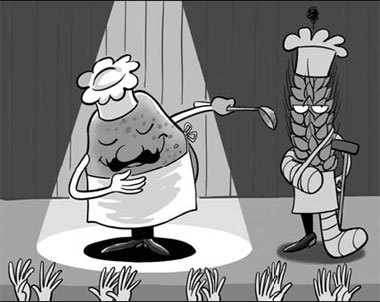Potato can help when other crops fail
By Abdul Khaleque (China Daily)
Updated: 2008-04-29 07:32
Updated: 2008-04-29 07:32
The breakdown of long-distance commerce in food has worried Bangladesh, particularly because its neighbors have restricted export of rice in apprehension of the world-wide food scarcity.
Bangladesh has a landless and incomeless population of about 20 million, which needs to be provided healthy food either free or at subsidized rates.
About 150 years ago, 50 percent of US farmers (95 per cent of the population) had in their individual ownership consolidated farm lands of at least 1000 acres; 30 percent of farmers owned at least 400 acres in partnership. Today, American farmers constitute only about 4 per cent of the population.

Fragmented land tenures in Bangladesh, by contrast, make scientific production almost impossible for its agriculture. Canals, ponds, playgrounds, grazing lands for cattle have substantially disappeared. Above all, the threats of climatic change, earthquake, hurricane, hailstorm, etc and the rise of the sea level have made life potentially dangerous.
The availability of food has increased in recent centuries in places where the number of farmers has decreased. The success of modern agriculture has been related not only to its mechanization but to the concurrent decline in the number of those working on it.
Before the 19th century, we hardly knew what food humans needed in order to live. Scientists say that there is a nitrogen component in living plants or animals and that all herbivorous animals build up tissues from protein of plant foods which are converted into muscles and other organs. It was discovered that humans and animals decline in health when they lack in vitamin, even if they have enough of protein.
Diversification of agriculture demonstrates the domination of grain or rice.
After wheat and rice, potato played an important role along with maize among the important crops of the world. Potato is a South American contribution to the world's food. It was taken to Mexico by the Spaniards. Before 1500, potato was known to be grown in the gardens.
The first Indian immigrants found wild potato as their best chance of a staple food. They knew potatoes in South America as "papas," which is still the Spanish word for potato. The potato was represented in Peruvian pottery as early as AD 200. It can be stored as well as dried, but it loses a third of its strength after three months.
Potato took a long time to become popular outside the Andes. No edible plant had been grown in the Old World from tubers rather than from seeds. No other plant previously had such mysterious, white or flesh-colored modules.
The tubers seemed to people at first to be deformed, like the feet of lepers. Many, indeed, thought that potato caused leprosy. When that disease vanished, scrofula was attributed to it. The coincidence of the coming of potato to Russia with the major cholera epidemic of the 1830s set back cultivation there for a generation.
Ireland was the first European country to grow potato plants systematically. Irish farmers of the 17th century were the first to realize that a quarter acre of land would yield twenty bundle weights of potatoes - which, with a few pigs, could feed a family better than any other crop on so small an area.
In France, it did not have that much popularity. In Burgundy, potatoes continued to be thought of as a kind of truffle till 1789. It was still not quite respectable in southern England until 1815. Balkan peasants in the 19th century would not eat "that cursed food hidden in the earth". Even in the 20th century there were educated people who regarded potato as "sheer poison".
Still, from the late 18th century, a good deal of propaganda was lavished by enlightened governments in an attempt to encourage the use of potato. It was served ostentatiously at the table of a French minister of the time.
In England, potato was widely cultivated in the north of the coal line. Adam Smith predicted that potato might replace wheat as the mainstay of the poor. He also thought that the strongest men and the most beautiful women of Britain (that is, the Irish) all lived on that root.
A historian of the potato plant, Professor Radcliffe Salaman, once argued that the widespread cultivation of the plant saved mankind from starvation. Peasants were impressed since it thrived when wheat harvest failed.
Potatoes also contributed a good deal both to cattle-raising and to the production of industrial alcohol during the 19th century. One could safely say that all prejudices were overcome after a careful examination of the potential quality of potato as a food item for humans in the main.
Despite its heavy protein, the potato is still one of the main foods in more than 30 countries. When a grain crop fails, people can fall on potato.
Adaptation of potato by the modern world has its significance in the context of the worldwide food crisis of our generation. Since habits die hard, some sort of campaign to form eating habits is necessary.
Bangladesh, with its limited farm land, is perhaps best suited to encourage the growth of potato cultivation on small patches of fertilized land. Large-scale potato farming may not be a bad idea for a country with such fragmented land tenures. But the idea needs to be popularized.
The Daily Star/Asia News Network
(China Daily 04/29/2008 page9)
|
|
|
|